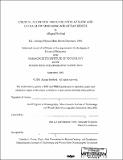Crustal accretion and evolution at slow and ultra-slow spreading mid-ocean ridges
Author(s)
Hosford, Allegra
DownloadFull printable version (17.20Mb)
Other Contributors
Woods Hole Oceanographic Institution.
Advisor
Jian Lin and Maurice Tivey.
Terms of use
Metadata
Show full item recordAbstract
Half of the ocean crust is formed at spreading centers with total opening rates less than 40 km/Myr. The objective of this Thesis is to investigate temporal variations in active ridge processes and crustal aging at slow-spreading centers by comparing axial crustal structure with that on conjugate flanks of the slow-spreading Mid-Atlantic Ridge (MAR) (full rate, 20 km/Myr) and the ultra-slow spreading Southwest Indian Ridge (SWIR) (full rate, 14 km/Myr). Seismic refraction data collected along the rift valley and flanking rift mountains of the OH-1 segment (35ʻN) at the MAR show that the entire crustal section is constructed within a zone that is less than 5 km wide. Shallow-level hydrothermal circulation within the axial valley is suggested by the rift mountain seismic profiles, which show that the upper crust is 20% thinner and 16% faster along strike than zero-age crust. These effects probably result from fissure sealing within the extrusive crust. Deeper crustal velocities remain relatively constant at the segment midpoint within the first 2 Myr, but are reduced near the segment offsets presumably by faulting and fracturing associated with uplift out of the rift valley. (cont.) A temporal variation in axial melt supply is suggested by a 15% difference in along-strike crustal thickness between the rift valley and rift mountains, with relatively less melt supplied today than 2 Ma. Crustal accretion at the SWIR appears to occur in a similar manner as at the MAR, although gravity and seismic data indicate that the average crustal thickness is 2-4 km less at theultra-slow spreading SWIR. A 25 Myr record on both flanks of the ridge shows that seafloor spreading has been highly asymmetric through time, with 35% faster crustal accretion on the Antarctic (south) plate. A small-offset non-transform discontinuity between two ridge segments is just as stable as two neighboring transform discontinuities, although a single mantle Bouguer gravity anomaly centered over the non-transform offset indicates that this boundary does not significantly perturb underlying mantle flow. Off-axis magnetic anomalies are recorded with high fidelity despite the very low spreading rates and the absence of a basaltic upper crust in one area. The lower crust may be the dominant off-axis carrier of the magnetic signal, contrary to traditionalmodels of crustal magnetic structure. Morphological and gravity data show evidence of asymmetric crustal accretion across the SWIR ridge axis, with slightly warmer mantletemperatures beneath the slower-spreading African (north) plate.
Description
Thesis (Ph. D.)--Joint Program in Oceanography (Massachusetts Institute of Technology, Dept. of Earth, Atmospheric and Planetary Sciences, and the Woods Hole Oceanographic Institution), 2001. Page 250 blank. Includes bibliographical references.
Date issued
2001Department
Joint Program in Oceanography; Woods Hole Oceanographic Institution; Massachusetts Institute of Technology. Department of Earth, Atmospheric, and Planetary SciencesPublisher
Massachusetts Institute of Technology
Keywords
Earth, Atmospheric, and Planetary Sciences., Joint Program in Oceanography., Woods Hole Oceanographic Institution.